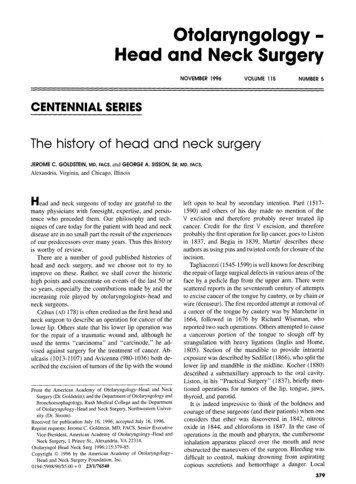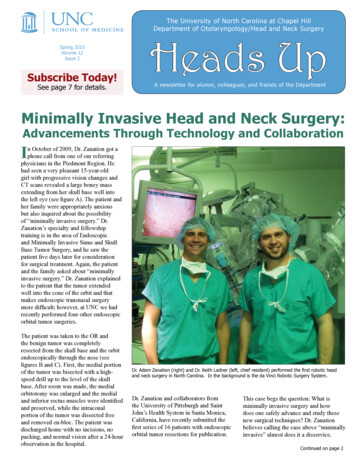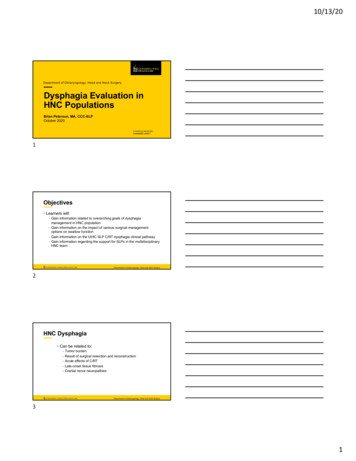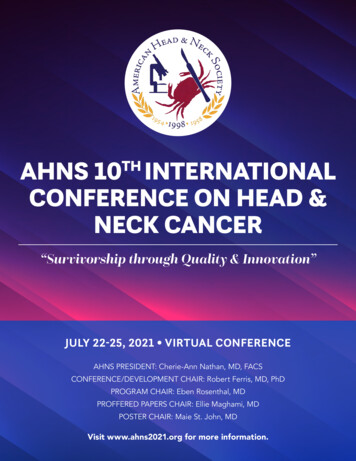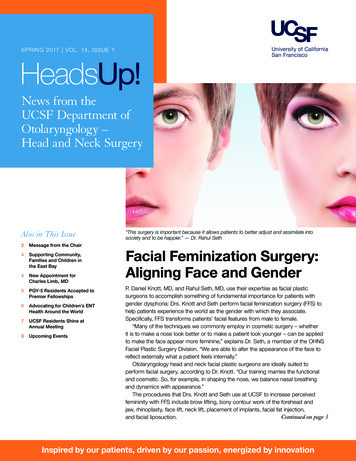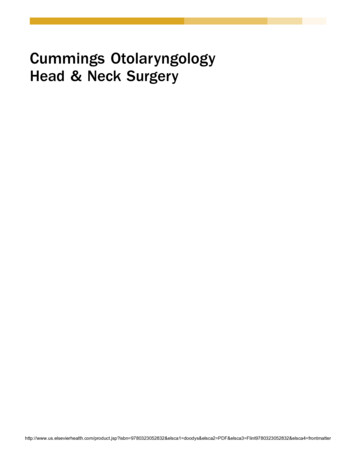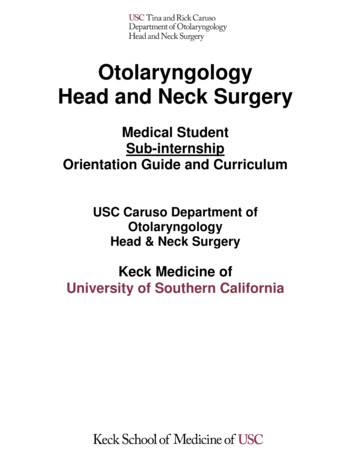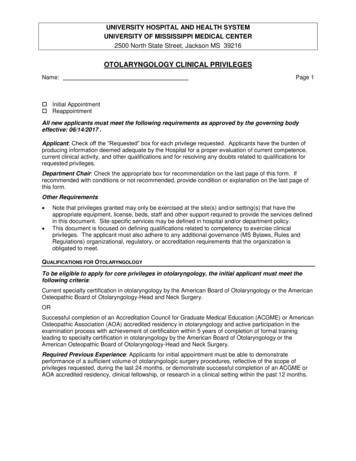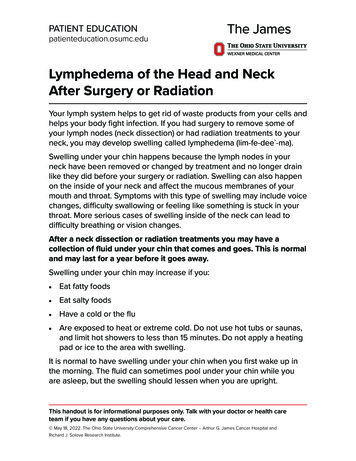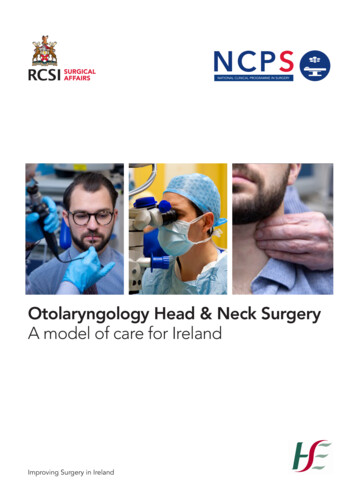
Transcription
OTORHINOLARYNGOLOGY, HEAD AND NECK SURGERY - A MODEL OF CARE FOR IRELANDNCPSOtolaryngology Head & Neck SurgeryA model of care for IrelandImproving Surgery in Ireland1
OTORHINOLARYNGOLOGY, HEAD AND NECK SURGERY - A MODEL OF CARE FOR IRELAND00CONTENTSOTORHINOLARYNGOLOGY, HEAD AND NECK SURGERYMODEL OF CARE FOR IRELAND1.List of tables42.Table of 6Overview of specialty157What ‘good’ looks like188Current state209New ways of working2510Scheduled and unscheduled surgical care delivery4011Workforce4612Future direction5713Measurement of specialty-specific KPIs5814Implementation plan5915Glossary of es903
01LIST OF TABLESTable 1Top 25 most frequent presentations by CCS for specialty ofORL-HNS in 201710Top 25 commonest interventions or operations delivered by the specialtyof ORL-HNS in 201711Table 3Most frequently performed procedures in 2017 by ORL-HNS subspecialties14Table 4Unscheduled presentation in 201714Table 5Diagnosis on discharge in 201714Table 6Recommendations18Table 7Current ORL-HNS consultant workforce20Table 8Hospital locations where current services are provided20Table 9Discharges by ORL-HNS21Table 24Table 10 Current availability of service delivery22Table 11 Complex ORL-HNS surgery23Table 12 OSPIP outpatient recommended timeframes28Table 13 ENT UK safe practice guidelines29Table 14 Acute vestibular assessment and rehabilitation clinic resource requirements30Table 15 Specialist combined respiratory and ORL-HNS multidisciplinaryresource requirements31Table 16 Paedaitric Otorhinolaryngology clinic resource requirementsfor tonsillectomy33Table 17 One-stop neck lump resource requirements34Table 18 Procedures currently performed in outpatient clinics34Table 19 Additional outpatient procedures35Table 20 Direct booking process to tonsillectomy39Table 21 ASAU unscheduled presentation criteria for ORL-HNS41Table 22 BUPA Codes for complex procedures42Table 23 HSE hospital modelling system43Table 24 WTE for Model 4 Dublin hospitals49Table 25 Future workforce recommendations50Table 26 Consultant subspecialty workforce: current and future requirements51Table 27 Saolta Hospital Group - Workforce recommendations54Table 28 Dublin Midlands Hospital Group - Workforce recommendations54Table 29 University of Limerick Hospital Group - Workforce recommendations55Table 30 South/South West Hospital Group - Workforce recommendations55Table 31 RCSI Hospital Group - Workforce recommendations55Table 32 Ireland East Hospital Group - Workforce recommendations56Table 33 Children’s Hospital Group - Workforce recommendations56Table 34 Model of Care-recommended KPIs: summary58Table 35 Internationally recognised KPIs58
OTORHINOLARYNGOLOGY, HEAD AND NECK SURGERY - A MODEL OF CARE FOR IRELAND02TABLE OF FIGURESFigure 1:Inpatient and day case waiting list12Figure 2:Outpatient waiting list13Figure 3:Outpatient waiting list volumes – actuals and forecast to June 202113Figure 4:Unscheduled discharges in 201716Figure 5:Scheduled discharges in 201716Figure 6:Bed days used in 201717Figure 7:Trend data for otorhinolaryngology and paediatric otorhinolaryngology17Figure 8:Variation across system21Figure 9:Scheduled and unscheduled discharges by hospital in 201722Figure 10: Head and neck cancer for all specialties: unscheduled andscheduled discharges by hospital in 201723Figure 11: Thyroid cancer for all specialties: scheduled and unscheduleddischarges by hospital in 201723Figure 12: Results of audiology direct referral initiative at South InfirmaryVictoria University Hospital25Figure 13: Waiting list for community audiology services, 201626Figure 14: Acute vestibular assessment and rehabilitation referral pathway30Figure 15: Specialist combined respiratory and ORL-HNS multidisciplinaryclinic referral pathway and resource requirements31Figure 16: Tonsillectomy and/or adenoidectomy variation32Figure 17: Paediatric otorhinolaryngology clinic referral pathway32Figure 18: One-stop neck lump clinic34Figure 19: ‘See-and-treat’ algorithm35Figure 20: Patient pathways37Figure 21: Epistaxis patient pathways38Figure 22: Discharges by specialty (NQAIS Clinical)40Figure 23: Overview of separation of scheduled and unscheduled care40Figure 24: Hub-and-spoke model41Figure 25: Unscheduled and scheduled discharges by hospital in 201743Figure 26: ANP Scope of practice47Figure 27: Fundamental principles of Sláintecare595
03RECOMMENDATIONSRecommendations1. Medical treatment of rhinitis and a proportion of ear microsuction can be treated inprimary care by general practitioners (GPs) who are appropriately trained in ORL-HNSprocedures. Each Hospital Group is to appoint a consultant as educational lead to roll outthe GP Education Programme.2.Primary care practitioners require better access to direct referrals to diagnostic audiologyand vestibular services.3.Outpatient referrals should be triaged according to the national Outpatient ServicesPerformance Improvement Programme (OSPIP) prioritisation model. Each HospitalGroup is to nominate an existing administrator to determine symptomatology of referredpatients who are on long-term outpatient waiting lists.4.Outpatient clinic capacity should follow Otorhinolaryngology best practice guidelines(Jardine A, 2017)5.Implementation of each of the following one-stop multidisciplinary clinics in each HospitalGroup: Acute vestibular assessment and rehabilitation clinic Specialist combined respiratory and ORL-HNS multidisciplinary clinic Rapid access speech/swallow clinics Paediatric ORL-HNS clinic (for assessment of obstructive sleep apnoea) Direct referral audiology/otology clinic Direct access neck lump clinic.6.Outpatient procedures should be costed by the HPO and procedures coded toincentivise cost savings through ambulatory care.7.Hospital Groups should implement day-of-surgery admissions (DOSAs), includingnecessary pre-admission support.8.A lead ORL-HNS consultant should be nominated in each Hospital Group with protectedsessions to ensure implementation of this Model of Care, patient safety and quality ofcare.9.Initiate development and implementation ofsymptom-specific e-referral templates for ORL-HNS.10. Implement a treatment algorithm for epistaxis to reduce admission rate and averagelength of stay (AvLOS).11. Increase day case and ambulatory surgical procedures, including tonsillectomy, in childrenand adults.12. Separate delivery of complex ORL-HNS scheduled surgery from routine ORL-HNSscheduled surgery.13. Designate and resource four specialty ‘hub’ centres delivering complex head and necksurgical oncology, supported by four ‘spoke’ sites nationwide, as recommended by theNational Cancer Control Programme (NCCP).14. Unscheduled ORL-HNS patients who fulfil the acute surgical assessment unit (ASAU)admission criteria should be streamed to the ASAU.6
OTORHINOLARYNGOLOGY, HEAD AND NECK SURGERY - A MODEL OF CARE FOR IRELAND15. Develop a hub-and-spoke model for Hospital Groups, with Model 2 and Model 3hospitals becoming the preferred location for routine scheduled day case procedures.Each Hospital Group is to audit equipment and staffing requirements necessary toprovide efficient outpatient services in satellite clinics.16. Each Hospital Group should calculate the number of protected beds required forinpatients and day cases within each Hospital Group.17. Each Hospital Group should determine theatre capacity and utilisation required to meetservice demands by employing the Theatre Quality Improvement Programme (TQIP)theatre performance software tool, which generates detailed operational analytics.18. Each Hospital Group should ensure the availability of anaesthesiologists specialising inday case surgery and ORL-HNS.19. In order to ensure patient safety, protocol-driven discharge in ORL-HNS should beimplemented.20. Implement a structured approach to specialty multidisciplinary workforce planning basedon demographics, the needs of the Hospital Groups, and subspecialty requirements.21. The specialty training and competency professional programme (CPD) programmesfrom the Royal College of Surgeons in Ireland (RCSI) should reflect future workforcerequirements and implementation of this Model of Care.22. Administration of human papillomavirus (HPV) immunisation for boys and girls should beencouraged in order to reduce oropharyngeal cancer occurrence.7
8
OTORHINOLARYNGOLOGY, HEAD AND NECK SURGERY - A MODEL OF CARE FOR IRELAND04FOREWORDModern practice in all branches of surgery has adopted multidisciplinary team care as itsfocus.Central to delivery of service in the many subspecialist areas of otorhinolaryngology – headand neck surgery (ORL-HNS) is the incorporation of specialists in physiotherapy, speech andlanguage therapy, and nutritional science.Models of care are an extension of this practice in hospital and community care, and areessential for efficiency of service. System services to schedule rehabilitation, optimisationof comorbidity management, and pre-operative anaesthetic assessment are all essential formodern practice, with efficient use of community, general practice and hospital facilities.Using models of care, it is estimated that referrals to outpatient departments will reduce byone-third, helping to reduce waiting lists and allowing all patients to benefit from qualityimprovement in all aspects of care.Implementation of these models of care will be critical. We must congratulate ProfessorMichael Walsh, National Clinical Advisor for ENT to the National Clinical Programme inSurgery (NCPS) for his enthusiasm and hard work to bring this project to fruition.Professor Deborah McNamaraJoint Lead, National ClinicalProgramme in SurgeryProfessor John HylandJoint Lead, National ClinicalProgramme in Surgery9
05INTRODUCTIONThe National Clinical Programme in Surgery (NCPS) has published models of care defining thestandards of care that should apply to acute (unscheduled) (NCPS, 2013) and elective (scheduled)(NCPS, 2011) surgical care in Irish hospitals. Refer Appendix 1 for MOC development methodologyand approval process. These services are delivered by multidisciplinary teams in a range ofdisciplines. The development of specialty models of care is the next step in defining best practice. Itallows a deeper understanding of the range of activity delivered by specialist services and of areaswhere there are unmet needs. It is also an opportunity for each specialty in surgery to define how themultidisciplinary surgical workforce can best deliver the care required by Irish patients, taking intoconsideration the new ways of working that are now the standard of care. Improvement of surgicalservices will require specialties to consider these new ways of working, such as one-stop clinics,delivery of services by health and social care professionals (HSCPs), advanced nurse practitioners(ANPs), clinical nurse specialists (CNSs) and physician associates where appropriate, and migration ofsome procedures towards ambulatory treatment instead of inpatient care. New technology has thepotential to change not only the diagnostic and therapeutic procedures that can be performed, butalso the way that surgeons communicate with patients, interdisciplinary team members, colleagues inthe community and their fellow surgeons.The starting point for the development of specialty models of care must remain the needs of Irishpatients and our responsibility to ensure that these services are accessible, safe, equitable and of highquality. They must also be delivered in a sustainable way. The 25 most frequent presentations, by theClinical Classification System (CCS), in the specialty of otorhinolaryngology – head and neck surgery(ORL-HNS) is outlined in Table 1, and the 25 commonest interventions, including operations, areoutlined in Table 2. It is immediately apparent that any specialty model of care must take into accountboth scheduled and unscheduled presentations as well as inpatient, outpatient and ambulatory care.Table 1: Top 25 most frequent presentations by CCS for specialty of ORL-HNS in 2017DiagnosisNationalChildHGDub MLHGIE HGRCSI HGSaoltaHGSthSWHGUL HGUpper respiratory disease – other7511332617194316971663789470Tonsillitis acute and chronic526751685655040211321308503Ear and sense organ – other4872457228109215161012391176Otitis media3214626350527327492662230Other aftercare2259669171773061733##Cancer head and neck1153##19124222422524920Benign neoplasm – other11096814325112822425738Surgical/medical complication10541312261567318822753Upper respiratory infection – other94929772042932099443Skin – other78820124136130112107159Child HGChildren’s Hospital GroupDisease of mouth non-dental7872313020312113812844Dub MLDublin Midlands HospitalGroupThyroid disorder693##85192756225918IEHGIreland East HospitalGroupFracture skull and face6628277586320545132Cancer skin – other non-epithelial564-12126403529151Injuries external cause – other462147472424976954Gastrointestinal – other439728102139905419Congenital anomaly – other378195183028434024Oesophageal 726##Care of prosthesis/device21320145796129##Cancer thyroid193-5631232852##Congenital anomaly digestive1843515####472454Secondary malignancy181-2949153751-Residual codes – unclassified14731####55261213Lower respiratory disease – other138176751313##10RCSI HGRoyal College of Surgeonsin Ireland Hospital GroupSaoltaSaolta Health CareHospital GroupSth SWSouth South WestHospital GroupUL HGUniversity of LimerickHospital Group## – Values under 5 are not displayedNo dataNote: Otorhinolaryngology, paediatric ear,nose and throat (ENT) specialtydischarges in 2017 from NationalQuality Assurance ImprovementSystem (NQAIS) Clinical which usesHospital In-Patient Enquiry (HIPE)data from the Healthcare PricingOffice (HPO).10Source: NQAIS Clinical (Health Atlas Ireland, 2018)
OTORHINOLARYNGOLOGY, HEAD AND NECK SURGERY - A MODEL OF CARE FOR IRELANDTable 2: Top 25 commonest interventions or operations delivered by the specialty of ORL-HNS in 2017Child HGChildren’s Hospital GroupDub MLDublin Midlands HospitalGroupIEHGIreland East HospitalGroupRCSI HGRoyal College of Surgeonsin Ireland Hospital GroupSaoltaSaolta Health CareHospital GroupSth SWSouth South WestHospital GroupUL HGUniversity of LimerickHospital Group## – Values under 5 are not displayedNo dataNote: Otorhinolaryngology, paediatricotorhinolaryngology specialtydischarges in 2017 from NQAISClinical which uses HIPE data fromthe HPO.Because of the complexity of headand neck cancer surgery, frequenterrors in coding are GDubMLIEHGRCSIHGSaoltaSth SWUL HGNo 13272091162201885Fibreoptic examination of pharynx2619##143121705167757Ear toilet, bilateral207119329255118013865152Tonsillectomy gotomy w insertion of tube,bil1962515240135100367430175Ear toilet, 87601672697447Tonsillectomy with adenoidectomy12132771425054339207144Low volume procedure ( 20/year)9659917619810513320252Closed reduction fx nasal ectomy withouttonsillectomy51912049411312310865Incision drain peritonsillar abscess5187567610417416821Arrest anterior nasal haem pack/cauterisation513##37471257825646Myringotomy w insertion of ###Microlaryngoscopy with removalof lesion38418638653489917Excision of lesion(s) squamous cellcancer, ear2939781816239653Perc [needle] biopsy of thyroidgland246########9233##Fibreoptic laryngoscopy23411187##102####Microlaryngoscopy w R/O lesion2222138692327377Microlaryngoscopy w R/O lesion216##3415101011429Excision of lesion(s) SSCT, ear205##6737##157010Remainder not in top 25procedures847889511831552106614771801530Source: NQAIS Clinical (Health Atlas Ireland, 2018)This table records Sth SW real time data for the following procedure in Dec 2018Nasendoscopy220Fibreoptic examination of pharynx5167Ear toilet, bilateral1368Septoplasty306Incision drain peritonsillar abscess174Arrest ant nasal haem pack/cauterisation78211
05INTRODUCTIONIn some areas, demand exists but current strategies are inadequate to meet this demand, resultingin waiting lists for outpatient ambulatory and scheduled care. Figure 1 and Figure 2 outline inpatientand outpatient waiting lists for treatment. While this reflects the current status of the known unmetneed within the specialty, including patients who are awaiting outpatient consultation and those whohave already been seen by a specialist and advised to have a procedure, it does not presently recordpatients who have been seen by a specialist and advised to have diagnostic tests, for example anX-ray, hearing test or scan.Figure 3 reflects a forecast for outpatient waiting list volumes which is represented by actuals and forecast to June 2021for the specialty based on the population growth.Day Case &Inpat s18-24Mths24-36Mths36-48Mths48 26,868% 1 Yr re 1 Inpatient day case wait list trend Nov 11-dec 18. Source- NTPF January 2019The inpatient and day case waiting list for ORL-HNS in January 2019 includes 5,283 patientswaiting inpatient or day case surgery. In 2018, there was a 23% decrease in patients. In2018, there was decrease in patients waiting for longer than 15 months. A number of factorscontribute to waiting list challenges in ORL-HNS, including, but not limited to, the availabilityof adequate and protected bed and theatre capacity. An area of particular concern is rollingtheatre closures arising from workforce challenges. More efficient utilisation of existingbeds and theatre capacity in Model 2 and Model 3 hospitals will increase capacity, butother initiatives such as ambulatory care centres are also likely needed. A high percentageof complex procedures in Model 4 hospitals means that low-complexity but high-volumeprocedures are not performed in such centres in sufficient numbers to meet demand, anddifferent ways of working within networks are required.12
OTORHINOLARYNGOLOGY, HEAD AND NECK SURGERY - A MODEL OF CARE FOR IRELANDThe outpatient waiting list for ORL-HNS at the end of January 2019 includes patients awaiting surgery. In2019, there was 9.3% increase in patients waiting for longer than 15 months.(31 Jan 2017) all 6-48Mths48 8% 1 %Note: increase in people waiting 15 months is 9.3% from 24,339 to 26,659Figure 2: Outpatient waiting list Data Source: NTPF 31-01-17Avg pr 89192.95 Yr 637145.8Lwr utpatient waiting list trend (Jun’13 - Dec’18) and projection to Mar’22 Otolaryngology & Pasediatric ENT specialitiesFigure 3: Outpatient waiting list volumes – actuals and forecast to March 2022Data Source: NCPS 2019The most frequently performed procedures by ORL-HNS subspecialties are represented inTables 3, 4 and 5. A total of 35,904 patients were discharged in 2017.13
05INTRODUCTIONTable 3: Most frequently performed procedures in 2017 by ORL-HNS subspecialtiesMost Common ProcedureTonsillectomy - Total3690Otology - Total7889Commonest Otology procedure numbersMicrodebridement of laryngoscopy2570Rhinology - Total2204Commonest Rhinology procedure numbersSeptoplasty687Endoscopic sinus surgery487Facial plastics (skin cancer, head and neck) Total1344Commonest Squamous Cell Cancer (SCC) procedure numbersSCC pinna1127Head/neck oncology - Total2135Commonest Head/neck oncology procedure numbersThyroid530Salivary375Lymph nodes316Mucosal782Cysts132Data Source: NCPS 2019Table 4: Unscheduled presentation in 2017ORL-HNS emergency presentationsNasal fracture728Peritonsillar abscess517Arrest nasal haemorrhage180Data Source: NCPS 2019Table 5: Diagnosis on discharge in 2017Principal diagnosis on discharge from inpatient care ORL-HNS – 19,190 patients discharged 2017DiagnosisNumber of patients per yearUpper respiratory disease7511Tonsillitis5267Otitis media3214Cancer head and neck1153Skin Cancer788Thyroid693Fracture (nasal)564Data Source: NCPS 201914
OTORHINOLARYNGOLOGY, HEAD AND NECK SURGERY - A MODEL OF CARE FOR IRELAND06OVERVIEW OF SPECIALTYORL-HNS is the oldest and third largest of the surgical specialties in the Republic of Ireland. Itmanages disorders of the ear, nose and throat and related structures in the neck (thyroid, salivaryglands) and the skull base. The specialty assesses and manages sensory losses such as hearing,balance, taste, smell, and the functional loss of speech and swallowing.ORL-HNS comprises the following subspecialty areas:»»Otology»»Neuro-otology»»Lateral skull base surgery»»Rhinology»»Anterior skull base surgery»»Facial plastic surgery»»Head and neck oncology»»Paediatric otorhinolaryngology»»Laryngology.All of these subspecialties form part of the ORL-HNS curriculum covering higher surgical trainingestablished by the Specialty Advisory Committee (SAC) in ORL-HNS.ORL-HNS involves the care of all age groups from the foetus (exit surgery is performed at the timeof delivery when the baby is attached to the placenta) throughout all stages of life up to the elderly.Figures 4 and 5 represent the age range of patients who presented to ORL-HNS specialists in 2017.15
06OVERVIEW OF SPECIALTYFigure 4: Unscheduled discharges in 2017Source: NQAIS Clinical Dec 2017. (Health Atlas Ireland, 2018)Figure 5: Scheduled discharges in 2017Source: NQAIS Clinical Dec 2017 (Health Atlas Ireland, 2018)Unlike many other surgical specialties, there is no medical equivalent to ORL-HNS; 80% of theoutpatient workload in general ORL-HNS involves medical management of the patient.Approximately 2% of the population is referred for ORL-HNS services, with an estimated 18referrals per 1,000 population. With appropriate training and support, a proportion of this workcould safely be provided in primary care as well as by other members of the multidisciplinary teams.Thirty-eight per cent of admissions were unscheduled; 12% of these had a surgical procedure, andthe non-surgical group accounted for 56.1% of bed days used (BDU) (Figure 6). This has a majordetrimental impact on routine scheduled care admissions.16
OTORHINOLARYNGOLOGY, HEAD AND NECK SURGERY - A MODEL OF CARE FOR IRELANDUnscheduled/scheduled and stay/day split of discharges from January 2017 to December 2017 byotorhinolaryngology/paediatric otorhinolaryngologyJan - Dec2017SummaryPatient who had a surgical primary procedurePatient admitted under surgical care not having asurgical primary procedureAll 554,1710,34171.7%11,61424,290Figure 6: Bed days used in 2017Source: NQAIS Clinical Dec 2017(Health Atlas Ireland, 2018)The most frequent unscheduled admissions are ingestion or inhalation of foreign bodies, lifethreatening infections such as abscess formation in the upper airway, airway obstruction, andhaemorrhage. Trends in data for ORL-HNS are represented in Figure 7, which confirms thatthere was no change in scheduled and unscheduled day case admissions from 2015 to 2017.Otorhinolaryngology and paediatric otorhinolaryngology trend, Q1 2015–Q4 2017 33% scheduled day case, 13.4%unscheduled. Activity static in the last two yearsFigure 7: Trend data for otorhinolaryngology and paediatric otorhinolaryngologySource: NQAIS Clinical Dec 2017(Health Atlas Ireland, 2018)17
07WHAT ‘GOOD’ LOOKS LIKEThis ORL-HNS Model of Care aims to improve the quality of care for patients by standardisingcare delivery, improving access to ORL-HNS services, and providing recommendations forimplementation by the Health Service Executive (HSE), hospital and community managers,clinicians, and multidisciplinary teams caring for patients.Table 6: Recommendations1. Medical treatment of rhinitis and a proportion of ear microsuction can be treated inprimary care by general practitioners (GPs) who are appropriately trained in ORLHNS procedures. Each Hospital Group is to appoint a consultant as educational leadto roll out the GP Education Programme.2.Primary care practitioners require better access to direct referrals to diagnosticaudiology and vestibular services.3.Outpatient referrals should be triaged according to the national Outpatient ServicesPerformance Improvement Programme (OSPIP) prioritisation model. Each HospitalGroup is to nominate an existing administrator to determine symptomatology ofreferred patients who are on long-term outpatient waiting lists.4.Outpatient clinic capacity should follow Otorhinolaryngology best practiceguidelines (Jardine, 2017)5.Implementation of each of the following one-stop multidisciplinary clinics in eachHospital Group: Acute vestibular assessment and rehabilitation clinic Specialist combined respiratory and ORL-HNS multidisciplinary clinic Rapid access speech/swallow clinics Paediatric ORL-HNS clinic (for assessment of obstructive sleep apnoea) Direct referral audiology/otology clinic Direct access neck lump clinic.6.Outpatient procedures should be costed by the HPO and procedures coded toincentivise cost savings through ambulatory care.7.Hospital Groups should implement day-of-surgery admissions (DOSAs), includingnecessary pre-admission support.8.A lead ORL-HNS consultant should be nominated in each Hospital Group withprotected sessions to ensure implementation of this Model of Care, patient safetyand quality of care.9.Initiate development and implementation of symptom-specific e-referral templatesfor ORL-HNS.10. Implement a treatment algorithm for epistaxis to reduce admission rate and averagelength of stay (AvLOS).11. Increase day case and ambulatory surgical procedures, including tonsillectomy, inchildren and adults.12. Separate delivery of complex ORL-HNS scheduled surgery from routine ORL-HNSscheduled surgery.18
OTORHINOLARYNGOLOGY, HEAD AND NECK SURGERY - A MODEL OF CARE FOR IRELAND13. Designate and resource four specialty ‘hub’ centres delivering complex headand neck surgical oncology, supported by four ‘spoke’ sites nationwide, asrecommended by the National Cancer Control Programme (NCCP).14. Unscheduled ORL-HNS patients who fulfil the acute surgical assessment unit (ASAU)admission criteria should be streamed to the ASAU.15. Develop a hub-and-spoke model for Hospital Groups, with Model 2 and Model3 hospitals becoming the preferred location for routine scheduled day caseprocedures. Each Hospital Group is to audit equipment and staffing requirementsnecessary to provide efficient outpatient services in satellite clinics.16. Each Hospital Group should calculate the number of protected beds required forinpatients and day cases within each Hospital Group.17. Each Hospital Group should determine theatre capacity and utilisation required tomeet service demands by employing the Theatre Quality Improvement Programme(TQIP) theatre performance software tool, which generates detailed operationalanalytics.18. Each Hospital Group should ensure the availability of anaesthesiologists specialisingin day case surgery and ORL-HNS.19. In order to ensure patient safety, protocol-driven discharge in ORL-HNS should beimplemented.20. Implement a structured approach to specialty multidisciplinary workforce planningbased on demographics, the needs of the Hospital Groups, and subspecialtyrequirements.21. The specialty training and competency professional programme (CPD) programmesfrom the Royal College of Surgeons in Ireland (RCSI) should reflect future workforcerequirements and implementation of this Model of Care.22. Administration of human papillomavirus (HPV) immunisation for boys and girlsshould be encouraged in order to reduce oropharyngeal cancer occurrence.19
08CURRENT STATEBased on a population of 4.7 million people in Ireland, the number of consultants workingin public practice currently represent 1 per 83,873 population. When taking into accountconsultants working in private practice, this reduces to 1 per 71,238 population versus therecommended level of 1 per 40,000 population (RCSI, 2003). Please refer to Table 7, whichdetails Ireland’s ORL-HNS consultant workforce, and Table 8, which details where ORL-HNSservices are provided by Hospital Group.Table 7: Current ORL-HNS consultant workforceCURRENT ORL-HNS CONSULTANTS IN IRELANDPublic consultant in ORL-HNS51Locum consultants ORL-HNS in posts6Total posts in public practice57Private consultant in ORL-HNS10Total number of consultants nationwide in public and private practice67Table 8: Hospital locations where current services are providedHospital GroupModel 2Ireland EastRoyal Victoria Eye and EarHospital (M2S)St Michael’s Hospital, DunLaoghaireSouth/SouthWestMallow General HospitalSouth Infirmary VictoriaUniversity Hospital (M2S)University ofLimerickEnnis HospitalNenagh HospitalModel 3Model 4Mater Misericordiae UniversityHospitalSt Vincent’s University HospitalUniversity Hospital Kerry*Cork University Hospital*University Hospital Waterford*University Hospital Limerick*Saolta UniversityHealth CareGroupLetterkenny University HospitalMayo University HospitalSligo University Hospital*University Ho
5 OTORHINOLARYNGOLOGY, HEAD AND NECK SURGERY - A MODEL OF CARE FOR IRELAND 02 TABLE OF FIGURES Figure 1: Inpatient and day case waiting list 12 Figure 2: Outpatient waiting list 13 Figure 3: Outpatient waiting list volumes - actuals and forecast to June 2021 13 Figure 4: Unscheduled discharges in 2017 16 Figure 5: Scheduled discharges in 2017 16 Figure 6: Bed days used in 2017 17
